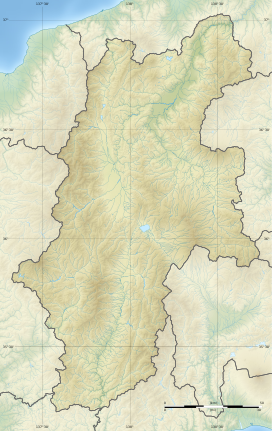Wada Pass (Nagano)
| 和田峠 | |
|---|---|
| English: Wada Pass | |
 Wada Pass Tunnel (contraflow of each direction due to narrow) | |
| Elevation | 1,531 m (5,023 ft) Nagawa, Nagano, Chiisagata District, Nagano Prefecture |
| Range | |
| Coordinates | 36°08′42″N 138°08′38″E / 36.145104°N 138.143923°ECoordinates: 36°08′42″N 138°08′38″E / 36.145104°N 138.143923°E |
 Wada Pass | |
Wada Pass (和田峠, Wada-tōge) is a mountain pass in between Nagawa, Nagano, Chiisagata District and Shimosuwa, Nagano, at an altitude of 1,531m. Nakasendo passed through this mountain pass. Japan National Route 142 runs through the mountain pass by Wada Pass Tunnel and Shin-Wada Tunnel.
Geo[]
One of the pass over the . Shinano River runs on the northern of the pass to Nihonkai, Tenryu River runs on the southern of pass via Lake Suwa to Pacific Ocean.
Outline[]
There were the place output of obsidian in Jōmon period around this pass.[1] Broad arrows which is made of obsidian produced from this pass was found in Kikonai, Hokkaido where keeps off about 650 km from this pass[2] Now, Wada Pass is famous for obsidian.[3] But, forbid to collect obsidian from the mount pass.[4]
History[]
Edo period[]
Nakasendo was constructed by Tokugawa shogunate, the mount pass belonged to the road. Besides, it is the most chokepoint of the road because of heavy snow and precipitous topo. So, the government developed Nishi Mochiya quarter which located Shimosuwa and Higashi Mochiya quarter and Settai quarter that located Wada-shuku as asylum cover and rest house.
On 18 December 1864, "Tengu-to" which was organized by retailers of the Mito Domain combatted against allied forces which were organized by Takashima Domain and Matsumoto Domain. Eventually Tengu-to rode to victory.
From Meiji period to before the World War II[]
In 1876, Koyobashi Shido was open to traffic as motoring road. In 1925, 和田嶺自動車 (Wadarei Motor) was established and ran through this mount pass. But, this road was closed during winter due to heavy snow, so in 1933, Wada Pass Tunnel was constructed.
After World War II[]

In 1953, the road was registered as Japan National Route 142. Wada Pass Tunnel is narrow, so vehicles are not able to run as two lanes. Eventually, now, the tunnel is mutual contraflow. In 1978, Shin Wada Tunnel was open to traffic.
Japan National Route 142[]
Shin Wada Tunnel was open to traffic in 1978 and this distant is 14,777m which had belonged to a toll road named Shin-Wada Tunnel Road in 1 April 2022,[5] however, the road which runs over this tunnel have gone free to pass though since 1 April 2022.[6]
Historic site[]
- Higashi Mochiya (There were hotels which were opened around Edo era)
- Roninzuka(The retailers of the Mito Domain who took part in the Tengutō Rebellion are buried)
Settai (A well which had been used until recently)
Higashi Mochiya (Now, there is not any hotel and rest house)
Others[]

"Wadaso" which belongs to Dianthus is named because found around Wada Pass[7]。
Adjacent post stations[]
- Nihombashi Direction ← Wada-shuku - (Wada Pass) - Shimosuwa-shuku → Sanjō Ōhashi Direction
Access[]
Toyohashi bus stop
- Forty five minutes' walk will bring you to the bus stop, it is located near "Roninzuka"
- Shimosuwa Community Bus
Tobira Sanso mae bus stop
- Two hours' walk will bring you to the bus stop
- Alpico Kotsu
Kannonzawa bus stop
- Fifty five minutes' walk will bring to the bus stop
- Nagawa Community Bus
- For Ueda Station (Nagano) via Tateshina Highschool[8] and Oya Station (Nagano)
See also[]
- Tengutō Rebellion
- Tsutomu Hata (His grandfather is "Sadayoshi Hata[9]" who managed 和田嶺自動車 that was operated around Wada Pass)
Bibliology[]
- ^ 黒曜石研究の動向・3 - 6節
- ^ "長野産黒曜石、北海道で出土 650キロ離れた縄文遺跡". 共同通信. 2018-12-14. Archived from the original on 2018-12-16. Retrieved 2018-12-16.
- ^ 地域資源全国展開支援事業・黒曜石物語
- ^ 和田峠の柘榴石(ガーネット)
- ^ About Shin Wada Toll Road
- ^ About free
- ^ "Kotobank What is Nadeshiko?". Retrieved 2018-05-09.
- ^ Transfer onto Chikuma Bus and Toshin Kanko Bus bound for Sakudaira Station and Iwamurada Station
- ^ About Sadayoshi Hata (published by National Institute of Informatics)
External links[]
| Wikimedia Commons has media related to Wada Pass (Nagano). |
- Mountain passes of Japan
- Mountain passes




